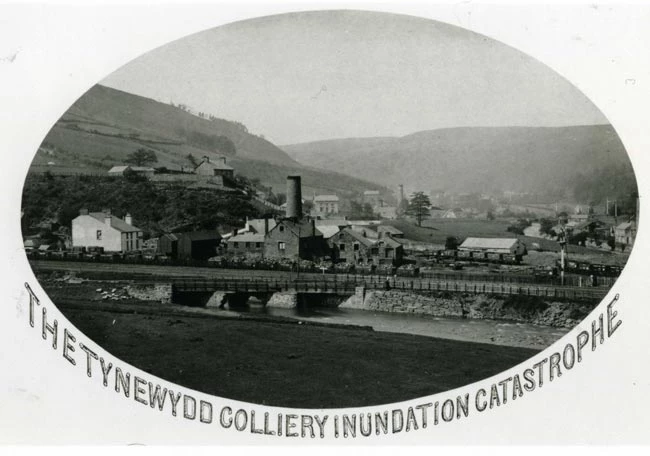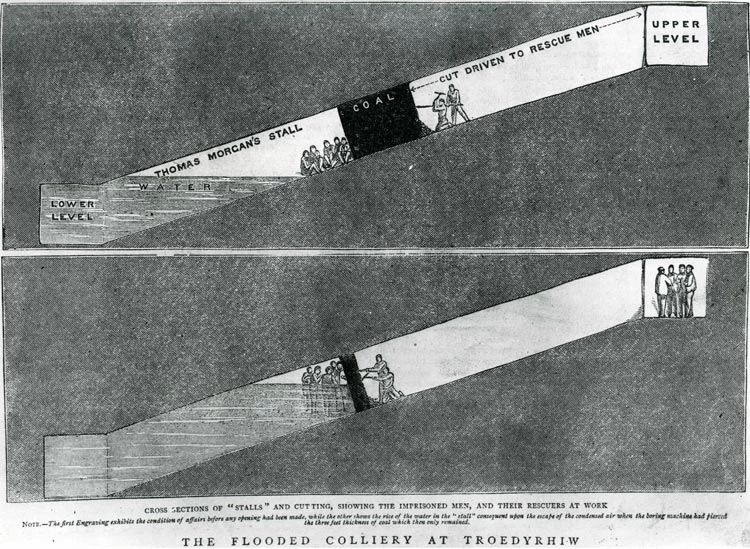Mission accomplished
The team of rescuers
Postcard commemorating the disaster
Caption reads:
'Cross section of "stalls" and cutting, showing the imprisoned men, and their rescuers at work. Note: The first engraving exhibits the condition of the affairs before any opening had been made, while the other shows the rise of the water in the "stall" consequent upon the escape of the condensed air when the boring machine had pierced the three feet thickness of coal that only then remained.'
Five of the survivors
In August 2010 a roof fall at the San Jose copper/gold mine in Chile trapped 33 miners 700 metres underground. After 69 days underground and a massive rescue operation, which involved NASA and more than a dozen international corporations, all 33 men were rescued over a 24 hour period. After winching the last trapped miners to the surface the rescue workers held a placard up for the cameras reading "Mission accomplished Chile". This was seen by an estimated television audience of more than a billion viewers around the world.
Tynewydd disaster
The Chilean rescue reminded many of a similar incident which occurred in the Rhondda Valleys over 130 years before. On the 11th April 1877 Tynewydd Colliery in Porth became flooded by water from the abandoned workings of the nearby Cymmer Old Colliery. At the time of the inundation fourteen miners were underground at Tynewydd and rescue attempts were begun to find them.
Five of the survivors were located after sounds of knocking were heard and rescuers had to cut through 12 yards of coal to reach them. Unfortunately, when the area was broken into, one of the trapped men was killed by the force of the air rushing out through the rescue hole. There were now nine men unaccounted for.
Desperate rescue attempts
Further sound of knocking were heard from working places beneath the water line which led to the rescuers assuming that there were other survivors trapped in an air pocket. An attempt was made by two divers from London to reach the men but the amount of debris blocking the roadways made this impossible. It was decided that the only way now was to cut a rescue heading through 38 yards of coal.
During the ten days it took to reach the five trapped men, the rescue attracted the attention of the world's press and telegrams were even sent by Queen Victoria who was concerned about the men's plight. The trapped miners were reached on Friday, April 20th; they had been without food and had only mine water to drink for ten days. The five rescued miners were found to be suffering from 'the bends' because of the rapid decompression of their air pocket and had to spend time in hospital but otherwise recovered fully. The four other missing miners were all drowned.
Brave and heroic rescues
Although the incident was a minor one in terms of loss of life (an explosion at Cymmer Colliery had killed 114 men and boys in 1856), the perseverance of the rescue teams attracted great press and public interest. Twenty four First and Second Class
and other presentation items were awarded to the rescuers in a ceremony held at the Rocking Stone above Pontypridd. It was estimated that up to forty thousand people attended.The Tynewydd rescue was the first time that Albert Medals had been awarded for bravery on land. Five of these medals are now held by Big Pit National Coal Museum along with examples of presentation silverware and other items connected with the rescue.
Article by: Ceri Thompson, Curator, Big Pit National Coal Museum




Comments - (10)
Dear Allan Woodliffe
We have five photographs in our collections which appear to have been taken around the time.
There are three photos of the men in their working clothes. One came from Isaac Pride’s grandson Emrys and the company that took that one was W&D Downey. These look like the type of images that Victoria would have wanted as one shows rescuers, one shows rescued and the third shows rescuers and rescued together.
However, we have three other photos of rescuers in their ordinary clothes.
Two of these photos show Isaac Pride, Gwilym Thomas and Abraham Dodd wearing the same clothes but in different positions in each photo. None of them are wearing their medals so probably taken shortly after the incident. One of these has Thomas Forrest as the photographer.
The other one shows Isaac Pride (in a different suit than above), David Minton, David Davies and Charles Oatridge. All have cigars but no medals. This was taken by Goodwaye and Williams. The sitters look less formal and rather heavy eyed and tired so may have been taken earlier than the above ones.
We now have two photographs of rescuers, along with their names, but as you know they are not all depicted.
I do have a further question, however. It is well known that Queen Victoria took a very close interest in the unfolding rescue - she had to be advised daily of the rescues progress by means of the newly installed telegraph.
When the rescue was completed, the Queen sent a photographer to the colliery so that she could see what these men actually looked like. I presume that the the two photographs of rescuers, and the one of the rescued, are part
of the portfolio he took. Does anyone know any more about the whereabout of any other photographs - I would assume that he would have taken more than thee!
Hi Pamela,
I originally had the names from a different photograph, and simply spotted the 'look alikes'. Your G.G.grandfather was easy to spot because, as you said, of his black face.
My interest is actually in mining gallantry awards, which I like to write about. This was the rescue that changed the Albert medal from a sea based gallantry award to one for both land and sea.
Co-incidentally my grandparents lived about a quarter of a mile from the filled in pit head, and I used to pass it most days on my way to school, so I have always had an interest in this particular rescue.
Reference Allan Woodliffe's comment of 15.6.2016: back row, 3rd from right is indeed John Williams. john Williams was my Great-great-grandfather. I have a copy of this photo and have always been able to pick him out as he has such a black face. Apparently he came straight from work to this photo shoot and they didn't have time to let him clean himself up first. I would be interested to know why Allan has been able pick him out, does he have a family connection too?
Siju,
I'm sorry we didn't get back to you with the information sooner - your comment must have slipped between the cracks.
Our curator, Ceri Thompson, spotted it and has answered your question as follows:
5 killed, 4 by drowning 1 by rush of compressed air (during initial rescue)
9 Saved (4 in initial rescue, 5 rescued later)
Thanks for your comment and for your patience,
Sara
Digital Team
Back Row L-R :- Thomas Griffiths, Charles Oatridge, John Williams, David Davies, David Minton, Thomas Rees, John B. Howells, Richard Hopkins, William Morgan, Morien (Historian)
Sitting L-R :- Thomas Thomas, Isaac Pride, John Davies, William Rawlins
Kneeling L-R :- David Davies, John Griffiths, Thomas Jones
So, well spotted indeed!
Ceri Thompson, Curator, Big Pit
Hi there Allan,
Thanks for your comment - you have a keen eye! I will contact our Curator of Coal and pass on your enquiry.
All the best,
Sara
Digital Team
Top row third left looks like John Williams (Albert Medal)
Top row right end is Morien (Morgan Owen) of the Western Mail.
Bottom row of two are John Griffiths & Thomas Jones.
All females had been banned from working underground from 1842.
Note the classic 1870's braided hairstyle on top of her head. Also her lower position in the picture; but also the protective male arms around her. Perhaps one is her husband or brother - in any case, often whole families would have to work in this industry.
As women worked above ground pushing coal trucks and doing other hard manual labour, it is only one next step to going to work in the mine itself.
Women at such work wore trousers under their skirts, anyway, and were tough characters, quite unlike the popular image of Victorian women as 'wimps'!